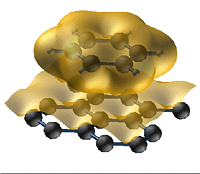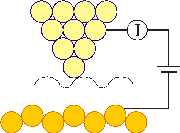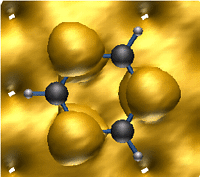Simulation of Benzene on Graphite
The starting point of this work was the experimental observation that images of weakly adsorbed organic molecules obtained by the scanning tunneling microscope (STM) differ strongly from what is expected from the from the molecular structure. It was of interest to see how far the electronic structure of the molecule is modified by the interaction with the surface, and why the images do not reflect the molecular structure.
Highly accurate electronic structure calculations have been performed to determine the structure of the molecule at the surface, the strength of the interaction between the surface and the molecule and to predict and explain the images obtained with the Scanning Tunneling Microscope.
 The figure on the left shows the electron density and structure of a benzene
molecule adsorbed on a graphite surface. The distance of the molecule from
the surface is 3.13 Angstrom. The calculated binding energy amounts to 35 kJ/mol.
The molecular density shows no distortion due to the interaction with the surface.
The figure on the left shows the electron density and structure of a benzene
molecule adsorbed on a graphite surface. The distance of the molecule from
the surface is 3.13 Angstrom. The calculated binding energy amounts to 35 kJ/mol.
The molecular density shows no distortion due to the interaction with the surface.
 The STM is a microscope that allows to resolve features on a surface
with atomic resolution. Gerd Binnig and Heini Rohrer of the IBM Zurich Research
Laboratory received the Nobel price for this invention. In an STM experiment the
tunnel current between the probed surface and an extremely fine metallic tip, that
is located only about 1nm above the surface, is measured.
A small voltage is applied between the surface and the STM tip and a finely
tuned feedback mechanism adjusts the height of the tip above the surface so that
the tunnel current remains constant. The electrons can traverse the barrier
between the surface and the tip only by a quantum mechanical phenomenon, tunneling.
The tunnel current can only proceed over short distances and decays rapidly
with increasing distance between surface and tip. The resulting sensitivity
allows to resolve extremely fine details such as individual atoms.
The STM is a microscope that allows to resolve features on a surface
with atomic resolution. Gerd Binnig and Heini Rohrer of the IBM Zurich Research
Laboratory received the Nobel price for this invention. In an STM experiment the
tunnel current between the probed surface and an extremely fine metallic tip, that
is located only about 1nm above the surface, is measured.
A small voltage is applied between the surface and the STM tip and a finely
tuned feedback mechanism adjusts the height of the tip above the surface so that
the tunnel current remains constant. The electrons can traverse the barrier
between the surface and the tip only by a quantum mechanical phenomenon, tunneling.
The tunnel current can only proceed over short distances and decays rapidly
with increasing distance between surface and tip. The resulting sensitivity
allows to resolve extremely fine details such as individual atoms.
According to the Theory of J.Tersoff and D. Hamann, the STM images are not related directly to the electron density but to the electrons with the highest energies, because only those have sufficient energy to leave the surface and enter the STM tip.


If we calculate the contribution of those electrons to the tunnel current, that have sufficient energy, we see only a three "bumps" despite the six-fold symmetry of the molecule. The explanation lies in the fact that the tunneling electrons have to pass through the molecule in an energy region, where the molecule has no orbitals. Because the electron has no states available on the molecule, it has to pass the molecule quickly and has no time to "forget" the surface. While it is passing its path is modulated by the molecule, so that the image is a combination of molecule and surface properties. The characteristic three-bump structure of the image is due to an interference effect, again a quantum mechanical effect, of the tunneling electrons.
Sources:
For further details see:
- "Adsorption and Scanning Tunneling Microscope Imaging of
Benzene on graphite and MoS2",
A.J.Fisher and P.E.Blöchl, Phys. Rev. Lett. 70, 3263 (1993) - "Adsorption and STM Imaging of Organic Molecules from First
Principles",
A.J.Fisher and P.E.Blöchl, Proc. NATO ARW "Computations for the Nano-Scale", Aspet, France, Oct. 12-16, 1992, edited by P.E. Blöchl, C. Joachim and A.J. Fisher (Kluwer, Dordrecht, 1993) Series E: Applied Sciences, Vol. 240, pp. 185-197.